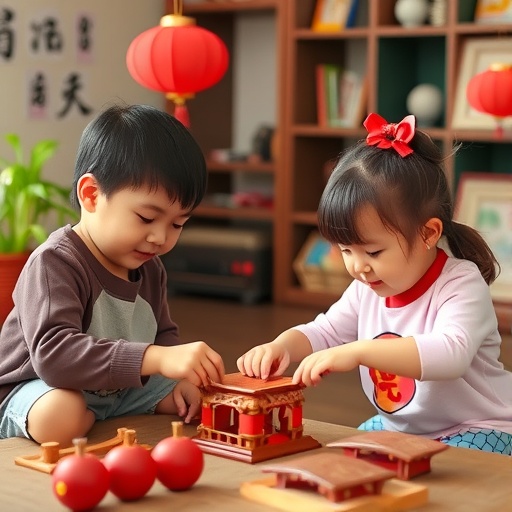In an increasingly interconnected world, the importance of preserving cultural heritage languages cannot be overstated. Recent research conducted by A. Cun underscores this necessity, particularly focusing on how guided play activities can effectively nurture Chinese heritage language and literacy among young learners. The study not only highlights the challenges faced by heritage speakers but also proposes innovative pedagogical methods that can be implemented in early childhood education settings.
The phenomenon of heritage language transmission has gained significant traction as immigrant families strive to maintain linguistic ties to their roots. However, children often struggle to balance the home language with the dominant language of their surroundings, leading to potential language loss. Cun’s research sets out to address this issue by exploring the efficacy of guided play as a medium for enhancing language acquisition and literacy skills among children who speak Chinese at home.
Guided play activities are designed to be both structured and playful, allowing children to explore language through interaction with peers and educators. This approach fosters engagement and enthusiasm for learning, setting the stage for effective language integration. Cun’s study emphasizes the role of educators as facilitators who guide children’s exploration while also providing essential vocabulary and linguistic structures crucial for language development.
The research employs a mixed-methods approach, comprising both quantitative and qualitative data collection to provide a comprehensive understanding of the subject. By observing children’s interactions during play, Cun evaluates the ways in which guided activities support language use within context. Such observations reveal the spontaneous language dynamics that emerge when children are placed in an interactive learning environment.
Furthermore, Cun’s findings suggest that guided play not only enhances children’s communicative competence in their heritage language but also strengthens their literacy skills. This dual focus is particularly important as literacy competency lays the foundation for academic success and lifelong learning. The study outlines how play-based learning can be seamlessly integrated into curriculum design, thus offering practical implications for educators.
A key aspect of Cun’s research is the focus on culturally relevant content. By incorporating themes and narratives that resonate with children’s lived experiences, educators can create a more meaningful learning pathway. This cultural connection not only bolsters language proficiency but also reinforces children’s sense of identity and belonging. The study advocates for educational frameworks that celebrate diversity and encourage children to embrace their heritage.
Moreover, the implications of this research extend beyond the classroom. By equipping parents with strategies for engaging their children in heritage language use during play, the study promotes a holistic approach to language and literacy development. Involving families in the educational process not only fosters a supportive learning environment at home but also enhances the overall linguistic experience for children.
In addition to its primary focus on language acquisition, the research raises awareness about the cognitive benefits associated with bilingualism. Children adept in multiple languages often exhibit enhanced problem-solving abilities, creative thinking, and cultural empathy. Cun’s exploration of guided play as a pedagogical tool highlights these broader benefits, reinforcing the notion that heritage language education is vital for the holistic development of children.
The increasing interest in play-based learning models within early childhood education aligns with the findings of Cun’s research. As educators seek innovative teaching methodologies, guided play presents an appealing option that resonates with contemporary educational philosophies. By merging play with structured learning objectives, educators can foster an atmosphere where children are motivated to learn and explore.
As the research prepares to make its mark in the academic community, it is evident that guided play workshops and teacher training initiatives will be essential to realize the potential outlined in Cun’s findings. Institutions and educational policymakers are urged to prioritize professional development that equips teachers with the skills to implement play-based language activities effectively. This investment in educator training will ultimately translate into enriched learning experiences for children.
In conclusion, Cun’s research paves the way for a reimagined approach to heritage language and literacy education through guided play. By acknowledging the societal and cultural significance of preserving heritage languages, this study emphasizes the vital role educators play in creating conducive learning environments. As we strive for a multilingual future, it is imperative to acknowledge and celebrate the linguistic diversity that children bring into our classrooms.
The social implications of supporting heritage language education cannot be overstated. As communities increasingly value bilingual capabilities, this research challenges conventional teaching practices and encourages systemic change. Achieving these outcomes requires collaborative efforts among educators, families, and policymakers dedicated to fostering an appreciation for children’s linguistic heritage.
In a world where globalization often marginalizes minority languages, Cun’s insights serve as a critical reminder of the importance of nurturing diverse linguistic landscapes. The study captures a pivotal moment in educational research, demonstrating the power of guided play as a transformative tool for language acquisition.
As the academic community awaits the official publication of Cun’s findings in the 2025 edition of the Early Childhood Educator Journal, the anticipation grows for a new wave of educators inspired to implement these principles in their classrooms, thereby creating a legacy of linguistic appreciation for generations to come.
Subject of Research: Chinese Heritage Language and Literacy Learning Through Guided Play Activities
Article Title: Chinese Heritage Language and Literacy Learning Through Guided Play Activities
Article References:
Cun, A. Chinese Heritage Language and Literacy Learning Through Guided Play Activities.
Early Childhood Educ J (2025). https://doi.org/10.1007/s10643-025-02082-8
Image Credits: AI Generated
DOI: https://doi.org/10.1007/s10643-025-02082-8
Keywords: Heritage Language, Literacy Learning, Guided Play, Early Childhood Education, Bilingual Education, Cultural Identity.




